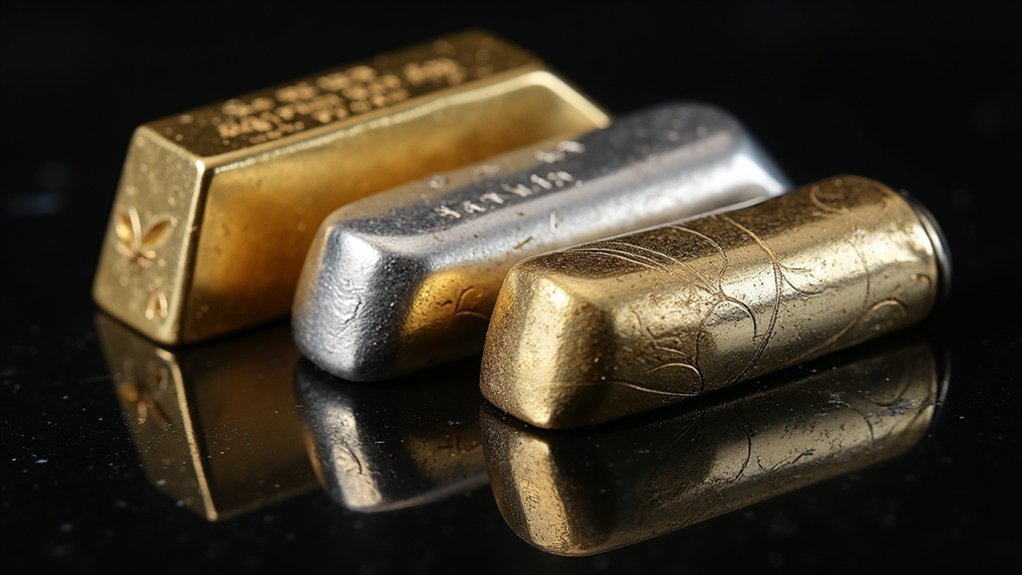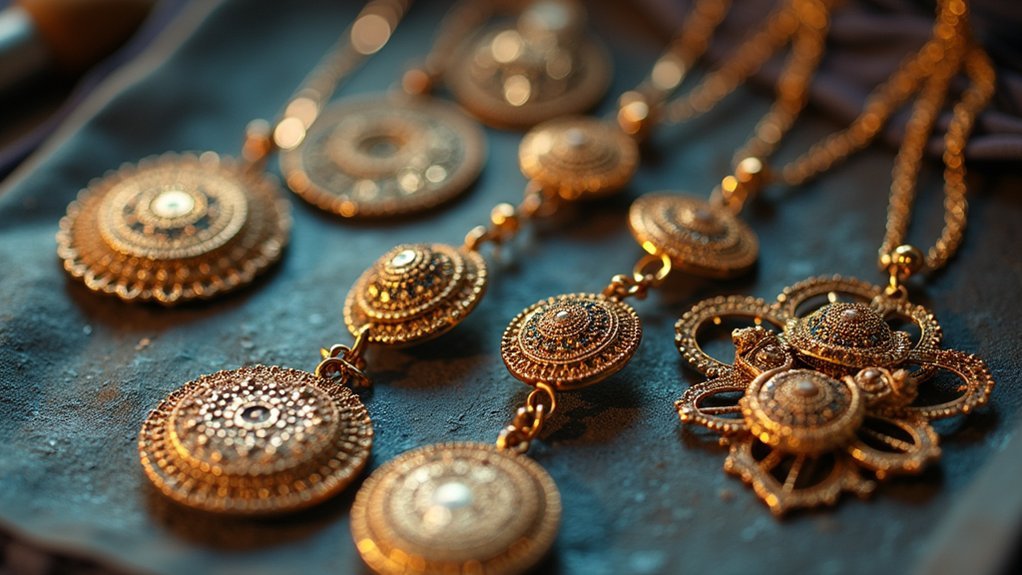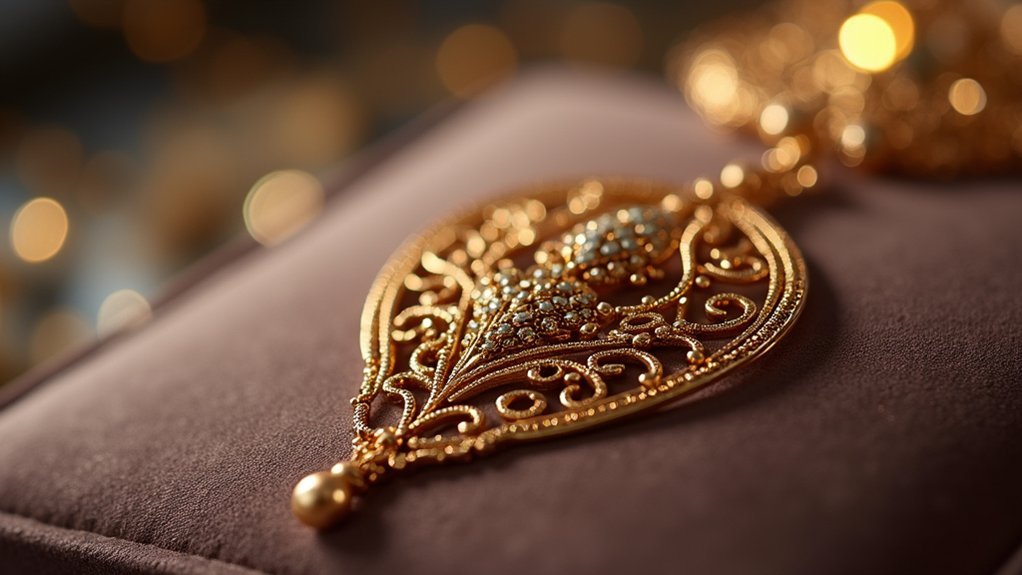Precious metals rank surprisingly low on the Mohs hardness scale, making them more vulnerable to scratches than you’d expect. Gold and silver both score just 2.5 out of 10, while platinum and palladium reach only 4. This means everyday items like keys, zippers, and stainless steel cutlery can easily scratch your gold and silver jewelry. Higher purity metals are actually softer and more prone to damage. Understanding these rankings will help you protect your valuable pieces more effectively.
Understanding the Mohs Hardness Scale for Precious Metals

The Mohs hardness scale provides a straightforward way to understand how easily your precious metals can scratch. This scale measures the scratch resistance of minerals, ranking them from 1 to 10, with talc being the softest and diamond the hardest.
You’ll find that precious metals have specific hardness values that determine their durability. Gold and Silver rank around 2.5 on the scale, making them relatively soft and prone to scratching. Platinum and Palladium score higher at approximately 4, offering better scratch resistance.
The scale’s ordinal nature means materials with higher rankings can scratch those with lower values. Understanding these hardness values helps you appreciate why certain precious metals require more careful handling and why mineral identification includes testing scratch resistance as a key characteristic.
Gold Varieties and Their Scratch Resistance
When you’re choosing gold jewelry, understanding that different gold varieties share surprisingly similar scratch resistance becomes essential for making informed decisions.
Most gold types register around 2.5 on the Mohs scale, making them vulnerable to everyday damage.
Gold’s 2.5 Mohs rating puts your treasured jewelry at risk from simple daily activities and common household objects.
Here’s what you need to know about gold’s scratch vulnerability:
- Your precious yellow, white, and rose gold pieces can be easily damaged by common items like keys or zippers.
- Even premium white gold alloyed with harder metals like palladium still scratches at the same rate.
- Your everyday stainless steel cutlery (hardness 4.5) will leave visible marks on your gold jewelry.
- Only 14k gold varieties offer slightly better resistance, reaching 3.5-4 on the hardness scale.
Regular contact with harder materials means all gold varieties require careful handling to maintain their appearance.
Silver’s Position on the Hardness Scale

Silver sits at exactly 2.5 on the Mohs hardness scale, placing it in the same vulnerable category as gold when it comes to scratch resistance.
You’ll find that everyday materials like coins and cutlery can easily damage your silver jewelry since their hardness level exceeds silver’s rating. This relatively low Mohs score means you’ll notice visible wear patterns developing over time when your silver pieces contact harder surfaces.
However, silver’s softness isn’t entirely disadvantageous.
You’ll appreciate how this characteristic allows jewelers to create intricate, detailed designs that wouldn’t be possible with harder materials.
While scratches are inevitable, you can restore your silver’s original luster through regular polishing and proper maintenance, effectively minimizing the appearance of surface damage.
Platinum and Palladium Durability Comparison
When you’re comparing platinum and palladium, you’ll find both metals rank around 4 on the Mohs hardness scale, giving them superior scratch resistance compared to softer precious metals like gold and silver.
You can rely on both metals to maintain their appearance over time since they don’t tarnish under normal conditions, making them excellent choices for everyday jewelry wear.
You’ll also notice that their higher density contributes to their overall durability, allowing them to withstand daily activities while potentially scratching softer metals they contact.
Mohs Scale Rankings
Two precious metals stand out for their superior scratch resistance on the Mohs hardness scale. When determining a minerals’ durability against scratching, platinum and palladium rank notably higher than traditional options. This scale of hardness reveals why these metals protect your most treasured jewelry investments.
The hardness of minerals directly impacts your jewelry’s longevity:
- Platinum’s mohs hardness of 4-4.5 means your engagement ring won’t easily show daily wear.
- Palladium ranks 4-4.75, offering exceptional protection for wedding bands.
- Both metals scratch gold and silver, demonstrating their superior strength.
- Your investment stays beautiful longer with reduced maintenance needs.
You’ll find these harder metals maintain their appearance through years of wear. While they’ll eventually develop patina, their resistance to scratching guarantees your precious pieces retain their structural integrity and value.
Scratch Resistance Properties
Understanding these Mohs rankings provides the foundation for examining how platinum and palladium perform in real-world conditions.
You’ll find that platinum’s Mohs hardness of 4-4.5 delivers superior scratch resistance compared to softer precious metals like gold and silver at 2.5. Palladium exceeds platinum with a hardness of 4.75, offering even better protection against daily wear and tear.
The hardness of a material directly impacts its durability in jewelry applications. When you wear platinum or palladium pieces, they’re less likely to show visible scratches over time.
These metals can actually scratch softer precious metals during contact. You can maintain their appearance through regular polishing, which restores shine and minimizes surface damage while preserving their long-term durability.
Everyday Wear Durability
While both metals offer excellent scratch resistance, platinum and palladium differ considerably in their everyday wear characteristics.
You’ll find that platinum’s superior durability makes it the gold standard for engagement rings enduring decades of wear. Its exceptional hardness of 4 on the Mohs scale guarantees your precious metals maintain their beauty through daily activities.
Consider these everyday wear advantages:
- Your platinum jewelry won’t scratch softer gold pieces when worn together
- You’ll experience fewer visible scratches during routine contact with harder surfaces
- Your investment remains protected through years of constant wear
- You’ll notice palladium offers similar scratch resistance while being notably lighter
Both metals outperform traditional gold and silver in everyday wear scenarios, giving you confidence that your jewelry withstands life’s demands without compromising appearance.
Everyday Items That Can Scratch Precious Metals
Although precious metals like gold and silver possess undeniable beauty and value, their relatively low Mohs hardness of approximately 2.5 makes them vulnerable to scratches from surprisingly common household items.
You’ll find that harder materials commonly found in your home can easily damage your precious jewelry. Coins made from copper and nickel will scratch your gold and silver pieces during casual contact.
Your stainless steel cutlery, with its 4.5 Mohs hardness, poses another significant threat. Even grabbing door handles made of brass or stainless steel while wearing rings can cause unwanted wear.
You should also be cautious about jewelry-on-jewelry contact, as different pieces rubbing together creates scratches.
Tools and everyday objects you handle regularly can gradually damage your precious metals through repeated exposure.
How Metal Purity Affects Scratch Resistance

When you’re shopping for precious metal jewelry, the purity level directly determines how easily your pieces will scratch during daily wear. Higher purity means softer metals that show damage more readily.
24k gold has a Mohs hardness of approximately 2.5, making it beautiful but vulnerable to everyday scratches. When you choose lower karat gold like 14k or 18k, harder metals in the alloy boost scratch resistance considerably.
Consider how purity affects your jewelry’s longevity:
Higher purity precious metals create stunning jewelry pieces, but their softer composition makes them more susceptible to scratches and daily wear damage.
- Your pure platinum ring will outlast sterling silver pieces due to superior hardness
- Lower hardness ratings mean more visible wear over time
- Harder metals mixed into alloys enhance overall durability
- Your investment deserves protection through informed metal selection
Understanding these relationships helps you balance beauty with practicality.
Protective Measures and Maintenance for Precious Metal Jewelry
Five simple protective measures can dramatically extend your precious metal jewelry’s lifespan and maintain its lustrous appearance. Professional cleaning removes accumulated dirt and restores shine while preventing long-term damage. Store pieces separately in soft pouches to prevent scratching during storage. Apply protective coating like jewelry wax to shield against everyday wear and tarnishing.
| Maintenance Method | Frequency | Purpose |
|---|---|---|
| Professional cleaning | Every 6-12 months | Restore shine, remove buildup |
| Protective coating application | Monthly | Shield from scratches, tarnish |
| Proper storage inspection | Weekly | Prevent piece-to-piece damage |
Use gentle, non-abrasive cleaners designed specifically for precious metals. Avoid wearing jewelry during physical labor or activities involving harder materials. Consider scratch kits for minor surface repairs between professional services.
Frequently Asked Questions
What Is the Hardness of Precious Metals?
You’ll find gold and silver have a Mohs hardness of 2.5, making them quite soft. Platinum and palladium are harder at around 4, so they’re more resistant to scratches from everyday wear.
What Is the Most Scratch Resistant Precious Metal?
You’ll find platinum and palladium are the most scratch-resistant precious metals. They’ve got a Mohs hardness of 4, making them considerably more durable than gold and silver’s 2.5 rating.
What Is the Highest Scratch Hardness?
You’ll find that diamond holds the highest scratch hardness at 10 on the Mohs scale. It’s the hardest natural material known, making it virtually unscratchable by any other substance you’ll encounter.
What Is the Mohs Hardness of 14K Gold?
You’ll find 14K gold has a Mohs hardness of 3.5 to 4, making it relatively soft. This means you can scratch it with stainless steel items, coins, or harder materials during everyday wear.
In Summary
You’ll find that precious metals have surprisingly low scratch resistance on the Mohs scale, with gold at 2.5-3, silver at 2.5-3, and platinum at 4-4.5. You can’t avoid all scratches, but you’ll minimize damage by choosing higher purity alloys, avoiding contact with harder materials, and storing pieces separately. You’re better off treating scratches as natural patina rather than fighting them completely, since proper care extends your jewelry’s lifespan considerably.





Leave a Reply